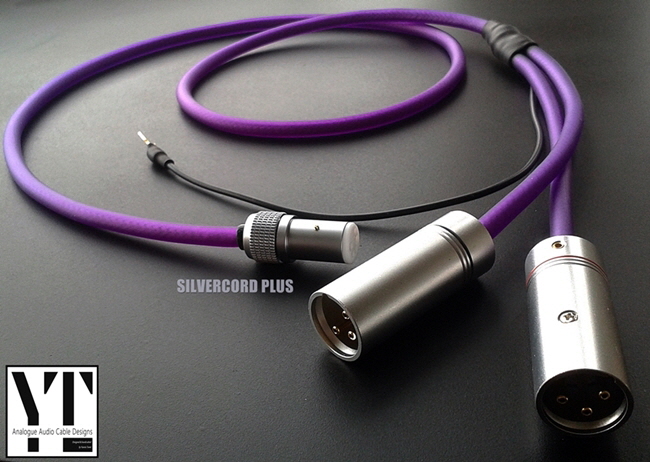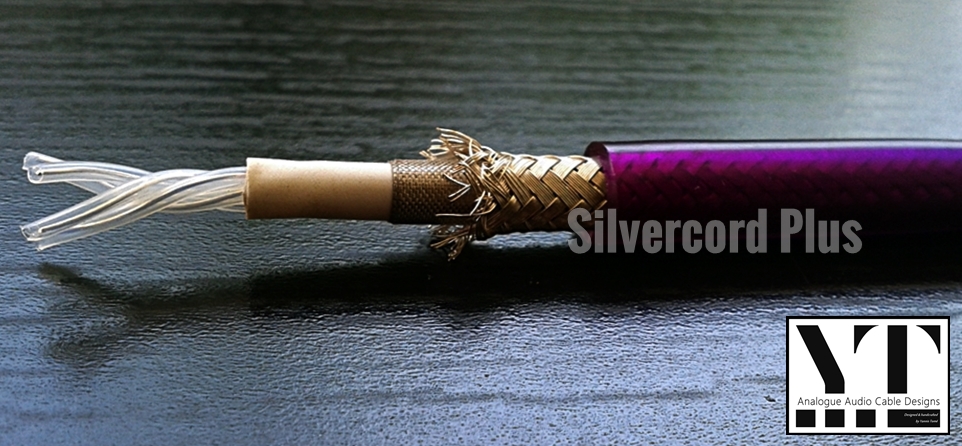

SILVERCORD PLUS is a pure, continuous casting silver cable designed specifically for the low level signal of the the phono cartridges. This extremely detailed interconnect phono cable does not require an entire silver signal path on your system to show its qualities. It is open and fast, without the typical brightness of silver cables. Its high purity silver cores in combination with the most appropriate dielectrics and geometries allow a truly natural and neutral performance which does not lack body or musicality. Music is crystal clear with a well defined mid-range and upper bass.
Silvercord Plus.features 4 solid OCC silver cores in an all air-Teflon multilayer dielectric and a starquad geometry.
The assembly is fully shielded by two layers of screening. Underneath the dense, tight weave silver plated OFC copper braid there is a nickel and copper fiber mesh to offer additional protection with added coverage and materials suitable for a broad range of frequencies. The cable is finished with an extremely flexible silicone jacket. This symmetrical, low capacitance cable (35pF/m) uses the same exactly high purity Ohno Continuous Casting silver as our top line cables. SILVERCORD PLUS has a very flexible and lightweight yet robust and durable construction allowing its use with ease, regardless any equipment and set-up space restrictions.Silvercord Plus is neither an “off the reel” cable finished with good quality plugs, nor a DIY project with a fragile construction, unaccounted electrical properties and questionable performance. It is the product of extensive research and development, entirely hand crafted by ourselves and it meets the highest standards in the industry
Despite its professional design, construction and finish, SILVERCORD PLUS is a no-frills cable. This approach allows us to offer it at a very competitive price. As always, our pricing is a direct reflection of cost of materials and work required to produce the cable. Nothing more and nothing less. Price is not an indicator of performance and this cable will put in shame cables costing many times more. We are really happy to have created such a cable at a price that can be affordable to more customers, preserving all the essential electrical characteristics and sonic qualities for a truly unique and enjoyable listening experience
The cable is finished with an airtight, purple (translucent) flexible silicone jacket.


Using the ground pins of the XLRs to make the ground connection (no external ground) is the most common configuration. However, certain phono preamp manufacturers recommend that the cable shields (Pin1 of the XLRs) should not be connected to the turntable. Instead the ground connection should be made using the external ground lead to the chassis of the phono preamp. If this is the case it will be clearly mentioned in the user manual of your phono preamp.
If you are not sure which choice is more suitable for you please get in touch and we will try to help.This option is only relevant if you choose to have your cable fitted with an angled tonearm connector. If you use a straight tonearm connector simply leave it to the default option
Not all tonearms have their pins rotated to the same direction. The pin orientation of your tonearm socket and the tonearm connector will determine the direction towards which the cable will exit the tonearm/turntable. By default all of our angled tonearm connectors are configured using “option 1” orientation as shown in the images, which is the most common. The choice depends on how the pins of your tonearm socket are rotated.
Option 1 is the default option for the vast majority of tonearms and tonearm cables.
Option 2 (180deg.) is the second most frequent option. It is typically used on Jelco tonearms but also on some Audioquest, Audiomods, Fidelity Research and Roskan models.
Option 3 is quite rare but it is often used on some SME tonearms when there is the need for the cable to be routed downwards.
Option 4 is the least common and it is typically used on Graham tonearms.
It is always advised to check your tonearm and see how its output pins are rotated so that you can choose the best option according your set up and cable “dressing” preferences.

SILVERCORD & COPPERCORD LINES OF ANALOGUE INTERCONNECT CABLES
The Coppercord & Silvercord lines of cables feature low capacitance, handmade, solid core cables. The cables offered in this series, follow a similar geometry and share many design ideas. However, there are significant variations regarding their conductor material, dielectric and shielding. A wide selection of connectors is available for all the variations across this range of cables.
The Coppercord & Silvercord series is designed to offer outstanding sonic performance, by a professionally constructed and finished cable assembly. At the same time, these cables have a minimal, ‘no frills’ appearance which allows us to offer them at very competitive prices despite the high quality of their materials.
All of our handmade cables are researched, designed and produced by ourselves in our workshop in Wales using raw materials. We do not use off the reel cables or pre-insulated conductors and all the cables are made on order to our customers’ specifications. We are responsible for all production and distribution so that our selling prices are free from any marketing and distribution overheads
Back In 2014 we decided to design a line of analogue audio cables which could deliver very similar performance to our CLIO cables but it could also be offered at an even more affordable price. A year later we launched Silvercord cables followed by Silvercord Plus. In this line of pure silver cables we also added our Coppercord cables (2016), featuring similar principles but using OCC copper instead of OCC silver as their signal conductors. In 2021 we also introduced the Silvercord Duo24 phono and line level interconnect cables. .
All of the phono cable designs in the Silvercord & Coppercord lines share some common principles: Very low capacitance, high purity continuous casting silver and copper conductors, insulation with very low dielectric involvement, heavy shielding using a minimum of a silver plated OFC copper braid with 98% optical coverage (this is one of the finest shielding braids available in the market, by far exceeding the standards of the shields used on audio cables) and a minimal but elegant appearance with an outer silicone compound cable jacket.
The challenge with such cable designs is to assemble and finish them in a manner that ensures consistency of the conductors alignment, durability against regular handling, resistance to the environmental impact, and a user friendly profile with suitable mechanical characteristics. Although the above seem straightforward and they are taken for given, they are usually absent from most handmade (and not only) high end cables. The finish of the cables is kept as minimal as possible but we have chosen to use a high quality airtight insulation for the cable jacket. Braided sleeves that are often used on handmade cables may look appealing but unless the cable assembly is properly finished with a suitable cable jacket, the braided sleeve will not offer any substantial protection to the cable. Braided sleeves allow air and moisture to penetrate a cable that does not have a proper jacket resulting to oxidization of the metal parts and higher levels of energy storing by the cable dielectric over a short period of time. At the same time braided sleeves offer very little in maintaining the dimensional stability of the cable and mechanically support to the inner assembly. They overall offer a very poor electrical isolation between the cable and its environment and their main role is to be used as an added layer of protection against vibration and handling; not to replace the cable jacket itself.
The extremely flexible silicone jackets we use on the SIlvercord & Coppercord cables, along with a combination of solid and medium density inner insulation and fine stranded braided shields result to a highly flexible profile. These cables can be used with ease on turntables that require extensive flexing of the signal cable and reduce any mechanical feedback on the tonearm itself. You will find that not only the sonic performance of the Silvercord & Coppercord cables is well above what their price suggests, but also their craftsmanship is beyond one’s expectations for such modest cables.
In a nutshell, the main reasons for choosing one of our Cord Series cables:
- One of the most effective shielding arrangements with a very high coverage and skin depth and low impedance to the ground
- Very low capacitance
- Extremely flexible (for ease of installation and minimal mechanical feedback/strain on the tonearm and the turntable suspension)
- Outstanding build quality and finish to ensure consistent performance and durability over a very long period of time.
- Dedicated, precision executed design, to accommodate optimal geometry, dielectric and conductor material.
